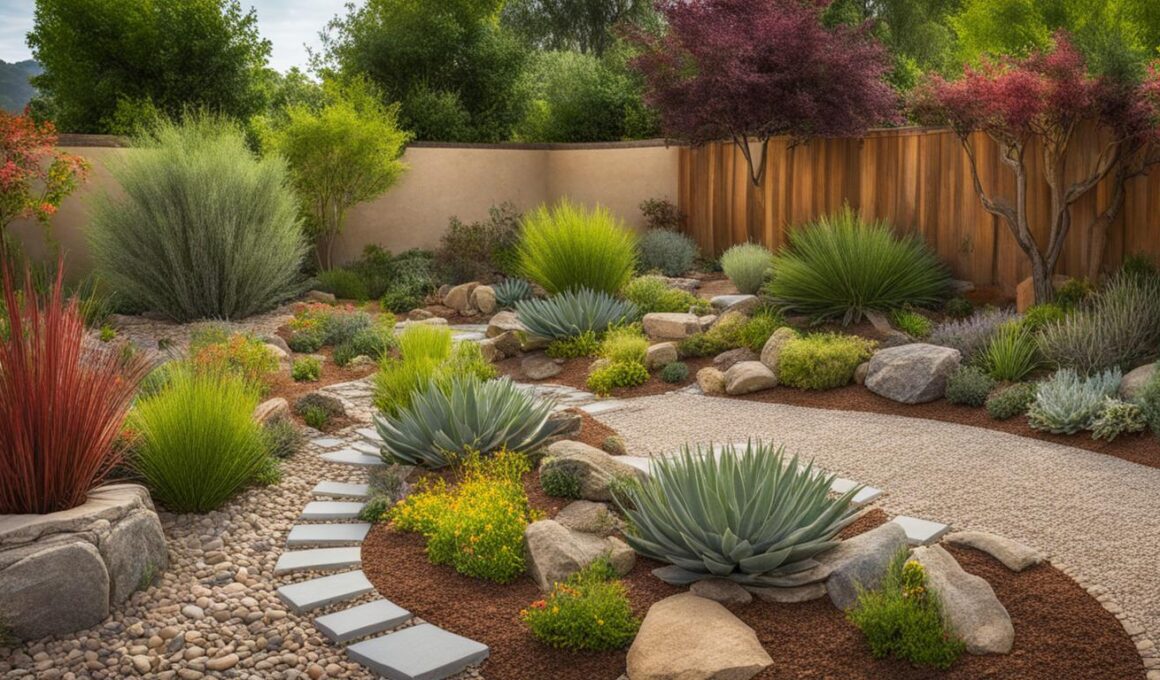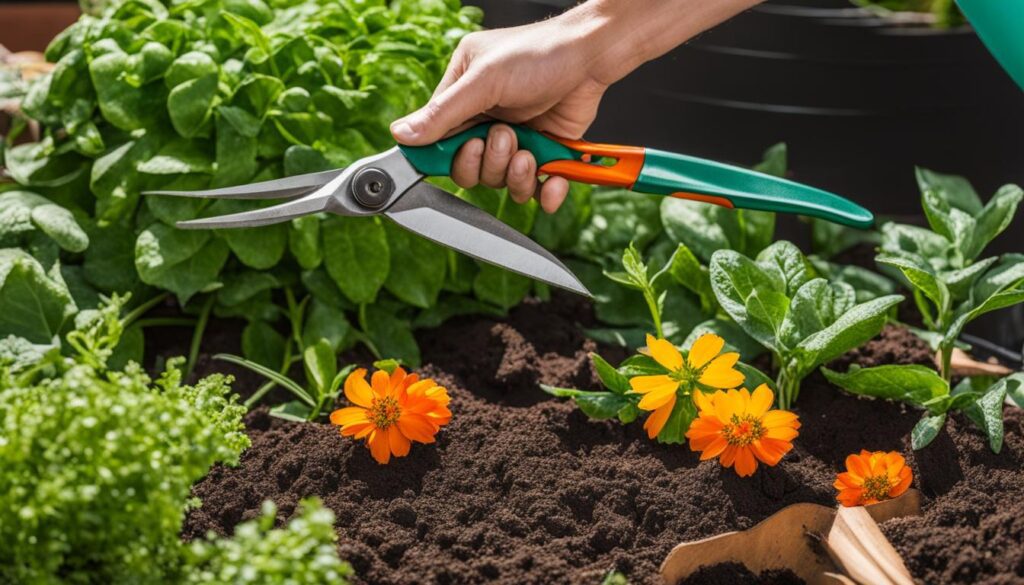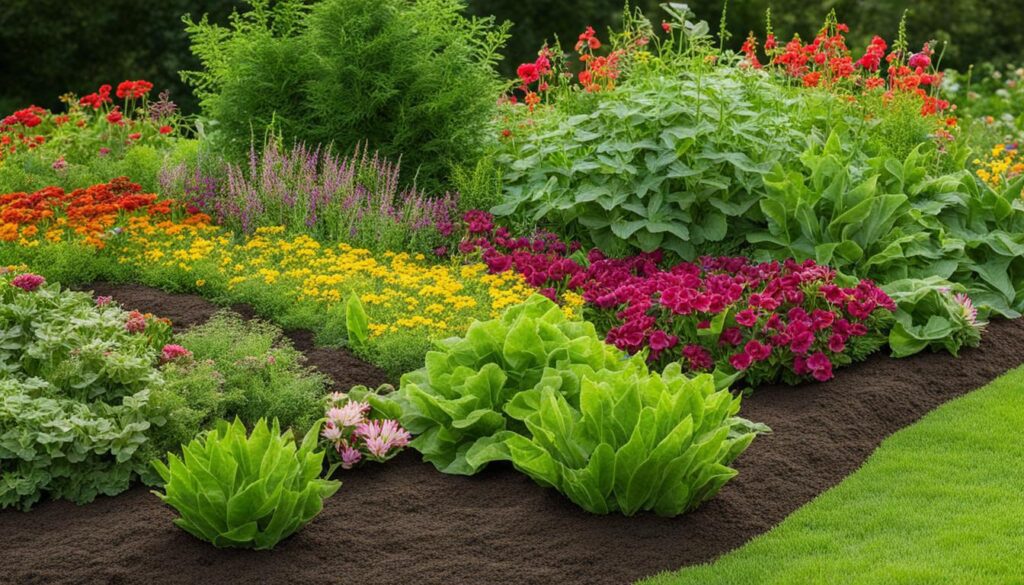Creating a water-wise and efficient xeriscape garden is not only practical but also environmentally conscious. By incorporating the right features and practices, you can conserve water in your garden and create a stunning landscape that thrives with minimal irrigation. Let’s explore some key water-saving features for your xeriscape garden:
Key Takeaways:
- Maximize efficiency, reduce water waste, and create an elegant landscape with minimal irrigation.
- Implement proper maintenance routines to promote plant health and reduce water usage.
- Follow efficient watering techniques to optimize water usage and support healthy plant growth.
- Choose appropriate fertilizers and apply them based on plant needs to minimize water requirements.
- Implement effective weed control strategies to conserve water and prevent competition with landscape plants.
Appropriate Maintenance for a Water-Wise Landscape
Proper maintenance is crucial for ensuring the success of your water-wise landscape. By following best practices in watering, fertilizing, weed control, pruning, and mowing, you can conserve water and reduce the maintenance requirements of your garden.
When it comes to watering, it’s important to prioritize efficiency. Deep watering allows plants to develop deep root systems, making them more resilient to drought conditions. By watering deeply and infrequently, you can encourage strong, healthy plant growth while minimizing water usage. Consider using a drip irrigation system or soaker hoses to deliver water directly to the plant roots, reducing evaporation and runoff.
Fertilizing is another maintenance task that can impact water usage. For native desert plants, supplemental fertilizers are typically unnecessary. However, non-native plants may require specific nutrients to thrive. It’s important to follow product label recommendations and only fertilize established plants to avoid wasteful nutrient leaching. Additionally, incorporating organic fertilizers or compost into the soil can improve its water-holding capacity and reduce the need for frequent watering.
Essential maintenance tasks for a water-wise landscape:
- Regular weeding: Removing weeds by hand or with tools prevents competition for water and nutrients.
- Consistent pruning: Proper pruning techniques promote water efficiency by ensuring plants use water efficiently.
- Efficient mowing: Adjust the height of your lawn mower to encourage deeper root growth and reduce water demand.
Proper maintenance plays a crucial role in ensuring the success of a water-wise landscape. By following best practices in watering, fertilizing, weed control, pruning, and mowing, you can conserve water and reduce the maintenance requirements of your garden.
By implementing these appropriate maintenance practices, you can create a low-maintenance, water-efficient landscape that thrives with minimal water resources. Not only will you save water and reduce your environmental impact, but you’ll also enjoy the beauty and serenity of a well-maintained garden. Remember to adjust your maintenance routine based on the specific needs of your plants and local climate conditions, and monitor the health of your landscape regularly to catch any issues before they become major problems.
Watering Tips for a Water-Saving Garden
To maintain a water-saving garden, it’s important to follow efficient watering practices. By implementing the following tips, you can optimize water usage and promote healthy plant growth:
- Water deeply and infrequently: Instead of frequent light watering, which encourages shallow root growth and evaporation, water your plants deeply. This encourages roots to grow deeper into the soil, making them more resilient and less dependent on frequent irrigation.
- Adjust watering frequency: Adapt your watering schedule based on the season and the specific needs of your plants. During hot, dry spells, increase the frequency of watering. In cooler or rainy periods, reduce watering to avoid overwatering.
- Maintain your irrigation system: Regularly inspect and maintain your irrigation system to ensure its efficiency. Check for leaks, clogs, or broken sprinkler heads and promptly repair them. Properly adjust the spray pattern to avoid watering non-landscaped areas.
By following these watering tips, you can conserve water while keeping your garden healthy and vibrant.
Deep Watering: The Key to Water Efficiency
“Deep watering encourages plants to develop deep root systems, which allow them to access water stored deeper in the soil. This helps plants cope better with drought conditions and reduces the need for frequent watering”.
Deep watering is one of the most effective strategies for water efficiency in your garden. By providing water directly to the roots, you ensure that it reaches the areas where it’s needed most, minimizing waste through evaporation. With deep-rooted plants, you can reduce watering frequency, save water, and promote plant resilience.
In summary, efficient watering practices, such as deep watering, adjusting watering frequency, and maintaining your irrigation system, are essential for a water-saving garden. By implementing these tips, you can reduce water usage and create a sustainable and thriving landscape.
Fertilizing for a Water-Wise Landscape
When it comes to creating a water-wise landscape, fertilizing plays a significant role in maintaining the health and vitality of your plants. While native desert plants typically do not require supplemental fertilizers, non-native plants may need specific nutrients to thrive. It’s important to follow product label recommendations and only fertilize established plants to avoid nutrient runoff and water pollution.
If you choose to fertilize your non-native plants, consider using organic fertilizers. These fertilizers are derived from natural sources and release nutrients slowly, providing a steady supply of nourishment to your plants. Not only do organic fertilizers promote healthy growth, but they also improve soil structure and increase water retention, reducing the need for frequent irrigation.
In addition to organic fertilizers, another way to support the water-wise nature of your landscape is by incorporating compost or a light top dressing of organic matter into your soil. This practice enhances soil health, increases water infiltration, and reduces water demand. By amending your soil with organic matter, you can create a nutrient-rich environment that supports plant growth while conserving water.
Using organic fertilizers and incorporating compost into your soil are excellent ways to promote a water-wise landscape. By nourishing your plants with natural, slow-release nutrients, you can encourage healthy growth while minimizing water usage. Remember to follow product label instructions and fertilize only established plants to maximize the benefits and minimize environmental impacts.
Native Plant Fertilization
- Native desert plants typically do not require supplemental fertilizers.
- These plants are adapted to the arid conditions of the region and are well-equipped to extract nutrients from the limited available resources.
- By choosing native plants for your landscape, you can minimize the need for fertilization, thereby reducing water requirements and maintenance tasks.
Organic Fertilizers
- Organic fertilizers, such as compost, manure, and bone meal, are derived from natural sources.
- They release nutrients slowly, providing a steady supply of nourishment to your plants.
- Organic fertilizers also improve soil structure, increase water retention, and promote beneficial microbial activity in the soil.
Using Compost
- Incorporating compost into your soil enhances its fertility and water-holding capacity.
- Compost helps break up heavy soils, allowing better water infiltration and reducing runoff.
- The increased water-holding capacity of the soil can reduce irrigation needs and improve plant health.
By adopting water-wise fertilization practices and focusing on the needs of your plants, you can create a thriving landscape while conserving water. Whether you choose to fertilize non-native plants with organic fertilizers or rely on the natural resilience of native desert plants, proper fertilization techniques can contribute to the overall sustainability of your water-wise garden.
Weed Control Strategies for a Water-Saving Garden
Weeds can quickly become a nuisance in your water-saving garden, competing with your plants for water and nutrients. Implementing effective weed control strategies is essential to conserve water and ensure the health of your plants.
Here are some organic weed control methods you can try:
- Early and consistent weeding: Regularly inspect your garden for emerging weeds and remove them promptly. By doing this, you prevent the weeds from taking root and using up valuable water resources.
- Hand or tool removal: For established weeds, carefully remove them by hand or with suitable tools. Be sure to extract the entire root system to prevent regrowth.
- Preventing seed formation: Remove weeds before they have a chance to flower and produce seeds. This proactive approach can help reduce future weed growth and conserve water in the long run.
- Minimizing soil disturbance: Avoid excessive tilling or digging, as it can disturb the soil and expose dormant weed seeds, leading to more weed growth. Instead, use mulch or other ground covers to suppress weed germination.
By incorporating these organic weed control strategies into your water-saving garden maintenance routine, you can minimize water competition between weeds and your desired plants, conserving water and promoting a thriving, sustainable landscape.
What Are Some Water-Saving Features I Can Implement in My Xeriscape Garden?
To incorporate xeriscaping principles for gardens, consider using drought-tolerant plants such as succulents and native species. Implement efficient irrigation systems like drip irrigation and rainwater harvesting. Mulch the soil to retain moisture and reduce water usage. These features will help conserve water in your xeriscape garden.
Pruning Techniques for Water Efficiency
Proper pruning techniques can significantly contribute to water efficiency in your xeriscape garden. By implementing the right methods, you can help your plants use water more effectively, reducing waste and promoting their overall health and vitality.
One essential aspect of water-wise pruning is to avoid shearing. Shearing, or the indiscriminate trimming of plants, can lead to increased water demand as it stimulates excessive growth and reduces the plant’s ability to conserve water. Instead, focus on selective pruning, which involves removing dead, damaged, or diseased branches, as well as shaping the plant in a way that allows for optimal water usage.
“Proper pruning methods can help your plants use water more effectively, reducing waste and promoting their overall health and vitality.”
When pruning shrubs in your water-saving garden, consider the following tips:
- Prune during the dormant season: Pruning during the cooler months, when plants are not actively growing, can minimize stress and water loss.
- Remove crossed branches: Eliminating branches that are rubbing against each other allows for better airflow and reduces the chances of disease.
- Follow species-specific guidelines: Different shrubs may have specific pruning requirements, so be sure to consult reliable resources or gardening experts for guidance.
By adopting these water-wise pruning techniques and incorporating them into your overall xeriscape garden maintenance routine, you can ensure that your plants use water efficiently, reducing your water consumption while maintaining a beautiful and sustainable landscape.
Conclusion
By incorporating these water-saving xeriscape garden features and following proper maintenance practices, you can create a beautiful and sustainable landscape that conserves water. Implementing efficient watering techniques, using appropriate fertilizers, managing weeds, and practicing proper pruning can help you reduce water usage, maintenance needs, and overall environmental impact.
Creating a sustainable garden is not only beneficial for the environment but also for your wallet. By conserving water, you can significantly decrease your water bills and contribute to the preservation of this precious resource.
Remember, efficient landscaping practices are key to achieving a water-saving xeriscape garden. By carefully selecting drought-tolerant plants, incorporating mulch, and utilizing water-wise irrigation systems, you can have a thriving garden while minimizing water consumption.
So go ahead and embrace these tips to create a stunning water-wise garden that not only benefits you but also contributes to a more sustainable future for our planet!














